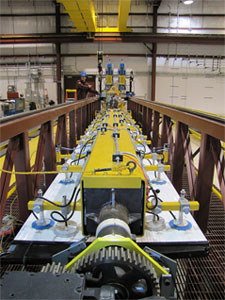Federal and state officials to celebrate opening of high-tech physics lab in northern Minnesota

Massive laboratory will support 15,000-ton particle detector that will help unlock mysteries of the origin of the universe
What: Ribbon-cutting ceremony of the NOvA far detector building. Speakers include:
• Glen Crawford, director, High Energy Research and Technology Division, Office of Science, Department of Energy
• Pier Oddone, director, Fermi National Accelerator Laboratory
• Eric W. Kaler, president, University of Minnesota
• Marvin Marshak, director, NOvA laboratory, School of Physics and Astronomy professor, College of Science and Engineering, University of Minnesota
When: Friday, April 27, 10:30-11:30 a.m. followed by guided tours until 2 p.m.
Where: NOvA Ash River Laboratory, 10709 Bright Star Rd., Orr, 55771 (For map and directions, please see http://z.umn.edu/novaribboncutting)
MINNEAPOLIS / ST. PAUL (04/23/2012) —Unlocking mysteries of the universe’s origin will take a landmark step forward this month with the opening of the NuMI Off-Axis Electron Neutrino Appearance (NOvA) far detector building, a laboratory of the School of Physics and Astronomy in the University of Minnesota, Twin Cities College of Science and Engineering. Officials from the U.S. Department of Energy, Fermi National Accelerator Laboratory (Fermilab) and the University of Minnesota will gather for a ribbon-cutting ceremony at the first-of-its-kind facility Friday, April 27, from 10:30-11:30 a.m. The ceremony will be followed by guided tours until 2 p.m.
Located near the Ash River, about 40 miles southeast of International Falls and 30 miles northeast of Orr, Minn., NOvA represents the world’s most advanced neutrino experiment. The unique laboratory was specifically designed to house a 15,000-ton particle detector that will study subatomic particles called neutrinos, fundamental building blocks of matter that can help researchers discover how the universe was formed and how it will develop in the future. The NOvA detector will measure neutrinos produced at Fermilab near Chicago and sent hundreds of miles straight through the earth to the new laboratory.
“As this remarkable NOvA facility opens, we celebrate a huge milestone on the journey to discover how our universe began,” said Marvin Marshak, laboratory director and professor in the University’s School of Physics and Astronomy. “Together with our Soudan Underground Laboratory, the NOvA building further establishes the University of Minnesota and the state as international leaders in neutrino research.”
Construction of the facility, which broke ground in May 2009, was supported under a cooperative agreement for research between the U.S. Department of Energy and the University of Minnesota. The DOE Office of Science provided $40.1 million in funding from the American Recovery and Reinvestment Act for construction, which was managed by Fermilab. Adolfson & Peterson Construction and their subcontractors completed more than 140,000 hours of labor in building the NOvA laboratory, providing a boon to the local economy.
The NOvA laboratory is no ordinary building. It contains a shielded detector hall that is 280 feet long and 67 feet wide with a 70-foot ceiling. To eliminate cosmic-ray radiation, the hall’s roof is shielded by four feet of concrete and covered by an additional six inches of barite. Attached to the hall is a 72-foot long assembly area and a 124-foot-long loading dock area with space to house dual overhead cranes. The block pivoter, weighing more than 750,000 pounds, will be used to move the more than 12,000 modules that comprise the neutrino detector into position.
With the laboratory successfully completed, work can now begin on assembly and installation of the neutrino detector. Constructed from individual modules weighing 1,100 pounds, the finished detector will comprise more than 13 million pounds of PVC and rank as the world’s largest PVC structure. Each module will be made at the University of Minnesota Module Factory, located in Minneapolis.
An additional $9.9 million in Recovery Act funding was supplied to Fermilab for purchasing key high-tech components from U.S. companies, enabling those firms to retain and hire workers. Starting in May, Fermilab will upgrade its complex of accelerators to provide the world’s most powerful beam of neutrinos to Minnesota.
“Neutrinos could be the key to understanding why matter exists,” said Fermilab Director Pier Oddone. “After years of preparation, we’re excited to see the NOvA experiment come together, and can’t wait until the first neutrinos make their way through this cutting-edge detector.”
An international collaboration, the $283 million NOvA experiment involves nearly 180 scientists and engineers from 28 institutions in seven countries. When the detector in Minnesota is completed, physicists will explore the mysterious behavior of neutrinos by examining pulses of the subatomic particles twice – as they leave Fermilab’s Illinois site and as they pass through the NOvA facility. The neutrinos travel the 500 miles in less than three milliseconds.
The new laboratory expands the university’s international reputation as a leader in neutrino research. The University of Minnesota currently operates the Soudan Underground Laboratory near Tower, Minn., the only laboratory of its kind in the United States.
In addition to Marshak, more than 45 staff and nearly 250 undergraduate students from the University of Minnesota’s Crookston, Duluth and Twin Cities campuses are involved in the project. William Miller is the supervisor for the university’s laboratory at Ash River.
About the School of Physics and Astronomy
The School of Physics and Astronomy is part of the University of Minnesota, Twin Cities College of Science and Engineering, one of the country’s top programs in engineering, physical sciences and mathematics.
About Fermi National Accelerator Laboratory
Fermilab is a Department of Energy Office of Science national laboratory operated under contract by the Fermi Research Alliance, LLC.
About the Office of Science
The Department of Energy Office of Science is the single largest supporter of basic research in the physical sciences in the nation and helps ensure U.S. world leadership across a broad range of scientific disciplines.
